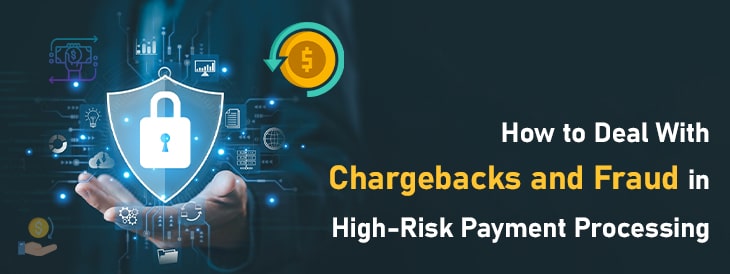How to Deal With Chargebacks and Fraud in High-Risk Payment Processing
How to Deal With Chargebacks and Fraud in High-Risk Payment Processing

Navigating the complexities of high-risk payment processing requires a proactive approach to chargebacks and fraud. For businesses operating in industries deemed high-risk, such as e-commerce, travel, or adult services, understanding the nuances of chargeback prevention is essential.
Chargebacks not only impact your bottom line but can also jeopardize your merchant account status. Implementing effective high-risk fraud solutions can significantly reduce the likelihood of chargebacks, safeguarding your revenue and reputation.
By leveraging advanced fraud detection tools, training your team on best practices, and fostering transparent communication with customers, you can create a more secure transaction environment. In this blog post, we will explore actionable strategies to mitigate the risks associated with chargebacks and fraud, helping you maintain a thriving business amidst the challenges of high-risk payment processing.
Understanding High-Risk Payment Processing
High-risk payment processing refers to handling transactions in industries that are more susceptible to chargebacks and fraud. This designation typically applies to businesses in sectors like e-commerce, travel, adult services, and subscription-based models, among others.
Due to the higher likelihood of disputed transactions and fraudulent activity, these businesses often face stricter scrutiny from payment processors. They may encounter higher fees, more frequent account reviews, and the need for specialized fraud prevention tools.
Understanding the unique challenges associated with high-risk payment processing is crucial for merchants to effectively manage and mitigate risks.
Factors that contribute to a business being labeled high-risk include high transaction volumes, international sales, and products or services that are prone to consumer disputes.
To navigate this landscape, high-risk merchants must employ comprehensive strategies that encompass advanced fraud detection technologies, robust chargeback management systems, and rigorous customer verification processes.
Additionally, working closely with a payment processor experienced in high-risk industries can provide valuable insights and support. By staying informed about industry best practices and continually adapting to emerging threats, high-risk merchants can better protect their revenue and maintain operational stability.
Some Related Blogs
- The Latest Trends in Payment Processing Technology For High-Risk Businesses
- The Impact of Regulations on High-Risk Payment Processing
- Tips For Securing Your Online Payment Transactions For High-Risk Businesses
- Pros and Cons of Different Payment Processing Methods
Common Types of Fraud in High-Risk Transactions
High-risk transactions are particularly vulnerable to various types of fraud, each requiring unique countermeasures. One prevalent form is credit card fraud, where stolen or counterfeit card information is used to make unauthorized purchases.
This is often facilitated through phishing schemes or data breaches. Another common type is friendly fraud, also known as chargeback fraud, where customers dispute legitimate transactions to obtain refunds while keeping the purchased goods or services.
Account takeover fraud is another significant concern; cybercriminals gain access to customer accounts through credential stuffing or social engineering, subsequently making unauthorized transactions. Subscription-based businesses often face trial abuse, where customers exploit free trial periods by using multiple email addresses or payment methods to avoid charges.
E-commerce platforms may encounter triangulation fraud, where fraudsters purchase goods using stolen credit card information and resell them to unsuspecting customers. Lastly, merchant fraud, where unscrupulous vendors process fraudulent transactions to inflate sales figures or launder money, poses a significant risk.
Understanding these fraud types is crucial for high-risk merchants to implement effective preventive measures, such as advanced fraud detection systems, robust customer authentication processes, and comprehensive monitoring tools.
Chargeback Prevention Tips for High-Risk Merchants
Chargeback prevention is essential for high-risk merchants to maintain their financial health and operational stability. First, ensure your transaction descriptors are clear and recognizable to avoid confusion that might lead customers to dispute charges.
Use detailed product descriptions and high-quality images to set accurate expectations. Implement a robust customer service system, making it easy for customers to contact you and resolve issues before resorting to chargebacks. Offering multiple communication channels, such as phone, email, and live chat, can be beneficial.
Another effective strategy is to provide clear return and refund policies, making them easily accessible on your website. This transparency can reduce the likelihood of chargebacks from dissatisfied customers.
Employing advanced fraud detection tools can also help identify and prevent fraudulent transactions before they occur, thereby reducing chargeback incidents. Additionally, requiring CVV numbers for card-not-present transactions and using address verification systems (AVS) can add extra layers of security.
Regularly monitor your chargeback ratio and analyze patterns to identify potential problem areas. Training your staff on best practices for handling disputes and understanding chargeback codes can also be invaluable. By taking these proactive measures, high-risk merchants can significantly reduce their chargeback rates and safeguard their business operations.
Implementing High-Risk Fraud Solutions
Implementing high-risk fraud solutions requires a multi-faceted approach to effectively combat various types of fraud. Start by integrating advanced fraud detection systems that use machine learning algorithms to identify and flag suspicious transactions in real-time.
These systems analyze transaction patterns, customer behavior, and other risk indicators to provide actionable insights. Deploy multi-factor authentication (MFA) to add an extra layer of security, making it harder for unauthorized users to access customer accounts.
Additionally, use tokenization and encryption to protect sensitive customer data during transactions, reducing the risk of data breaches. Partnering with third-party services that specialize in fraud prevention can also enhance your security measures.
These services often offer tools such as device fingerprinting and geolocation checks to further verify the authenticity of transactions. Regularly update your software and security protocols to stay ahead of emerging threats. Incorporate automated chargeback alerts to quickly address disputes and reduce the window for fraudulent chargebacks.
Educate your team about the latest fraud trends and equip them with the skills to recognize and respond to potential threats. By employing these high-risk fraud solutions, you can create a more secure payment environment for your business and customers.
Best Practices for Managing Chargebacks
Effectively managing chargebacks is vital for high-risk merchants to protect their revenue and maintain operational stability. One key strategy is to maintain meticulous records of all transactions, including customer communications and any documentation related to sales and deliveries.
This can provide crucial evidence when disputing unjust chargebacks. Utilizing automated chargeback management tools can streamline the process, allowing for quick identification and response to chargeback notifications. Make sure to respond promptly to chargeback disputes, as timely action can significantly influence the outcome.
Enhancing customer service is another critical component; ensure your team is well-trained to handle disputes efficiently and resolve issues before they escalate to chargebacks. Regularly review and update your terms of service and refund policies to align with industry best practices and customer expectations.
Monitoring chargeback ratios and analyzing trends can help identify underlying issues that may need addressing. Finally, maintaining open lines of communication with your payment processor can provide additional support and insights, helping you stay ahead of potential problems.
By adopting these best practices, high-risk merchants can better manage chargebacks and minimize their financial impact.
![]()
Email us anytime!
Email customer service 24/7 at info@binarygateways.com
![]()
Call us anytime!
Reach customer care 24/7 at (801) 761-5001
